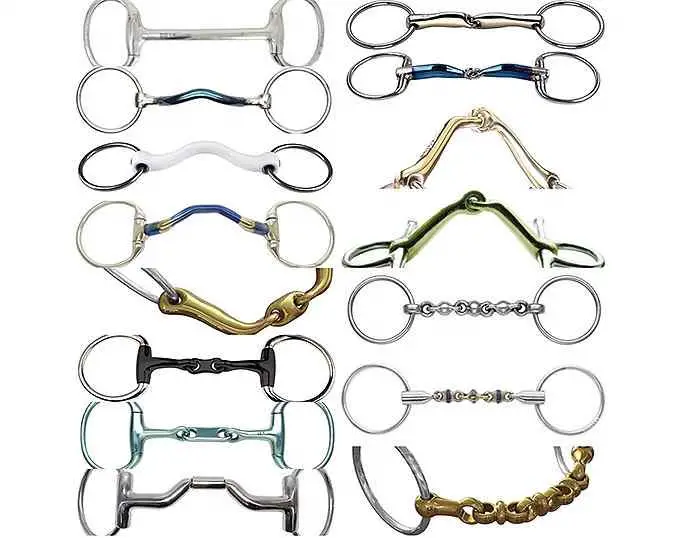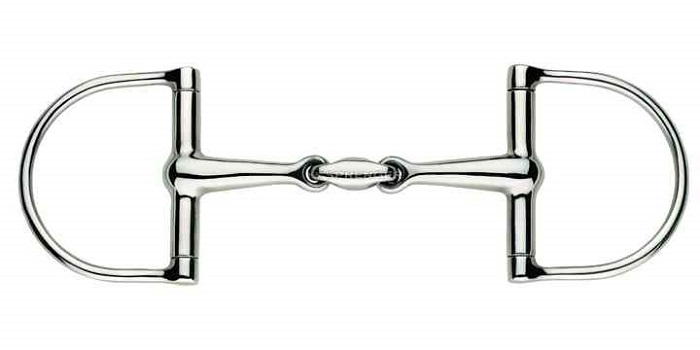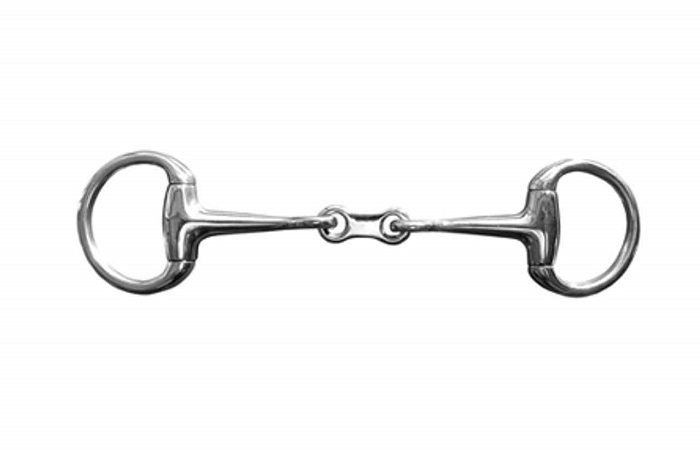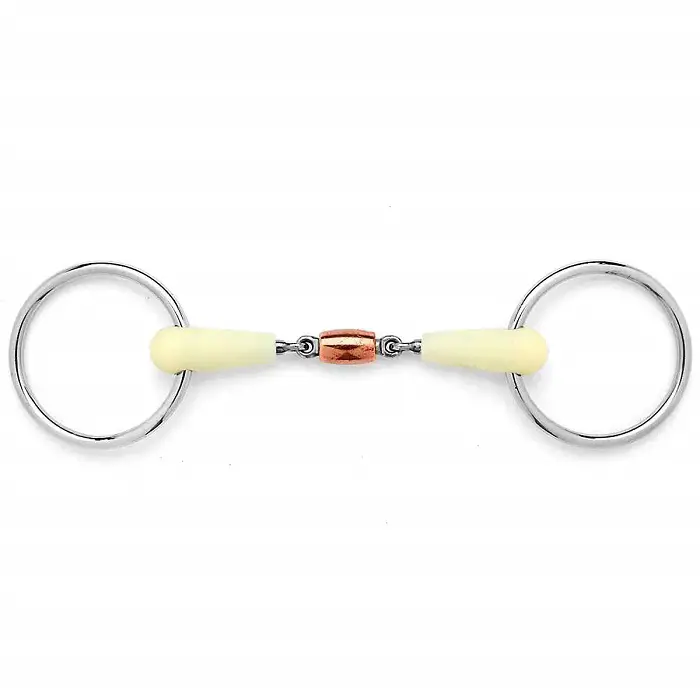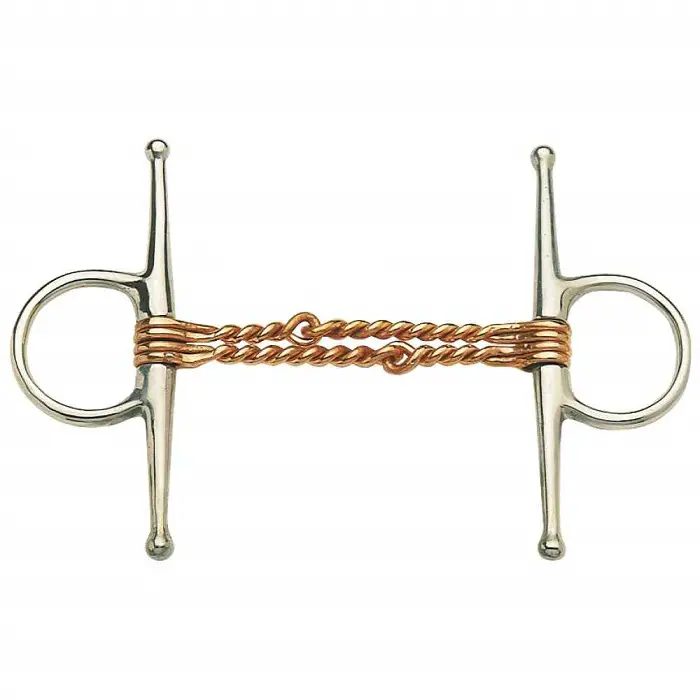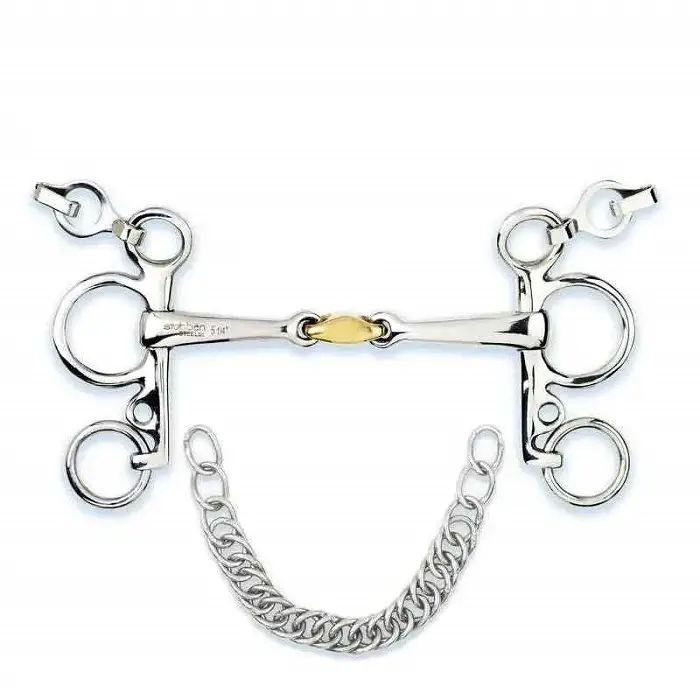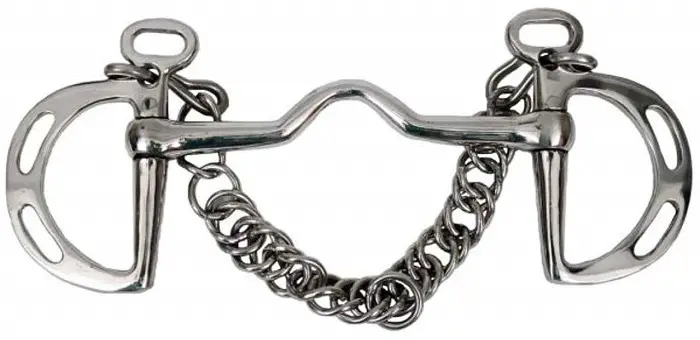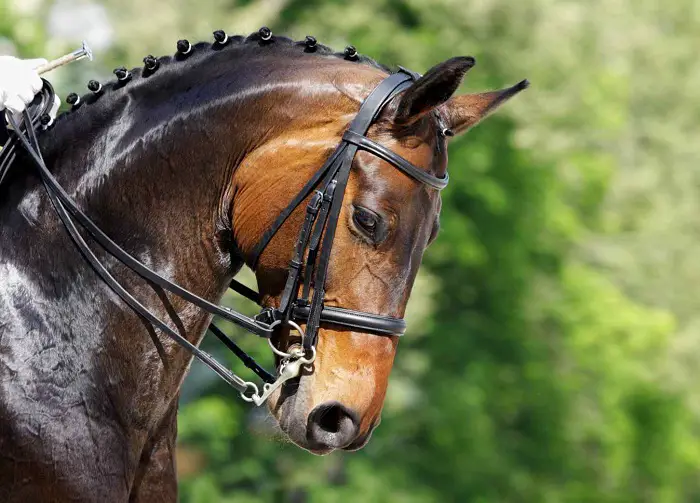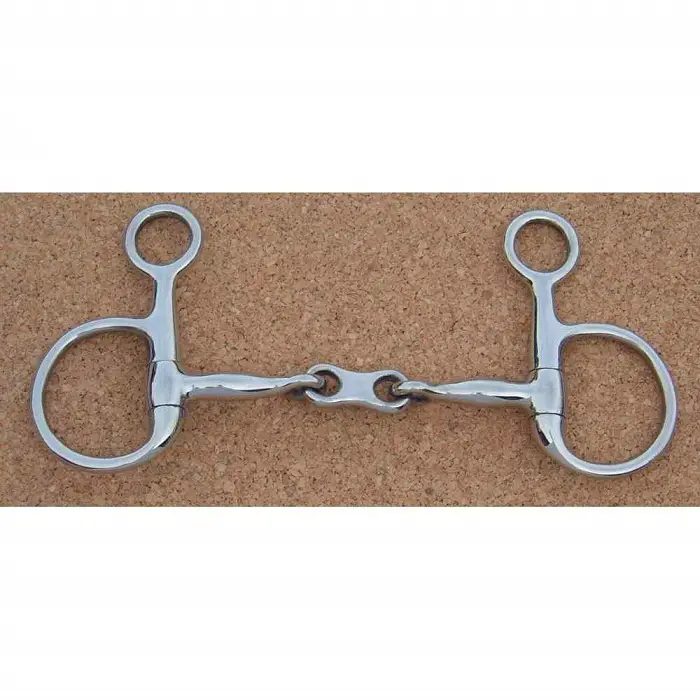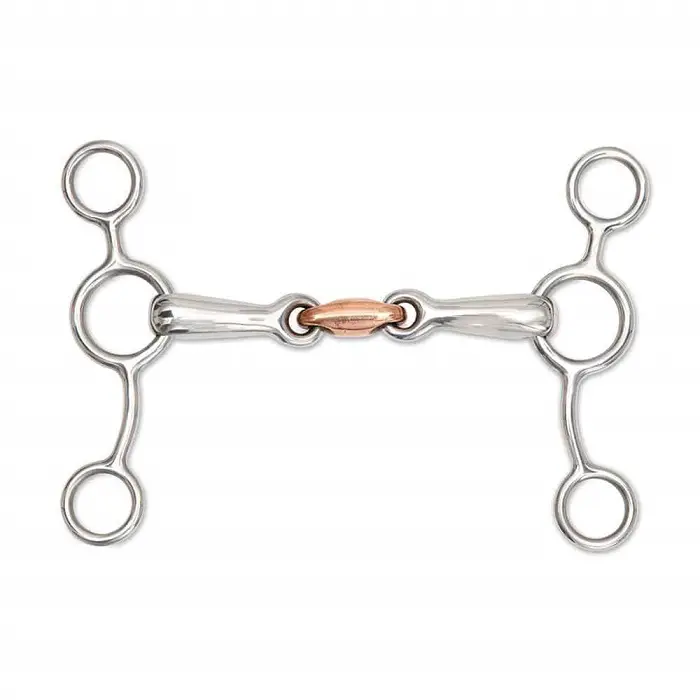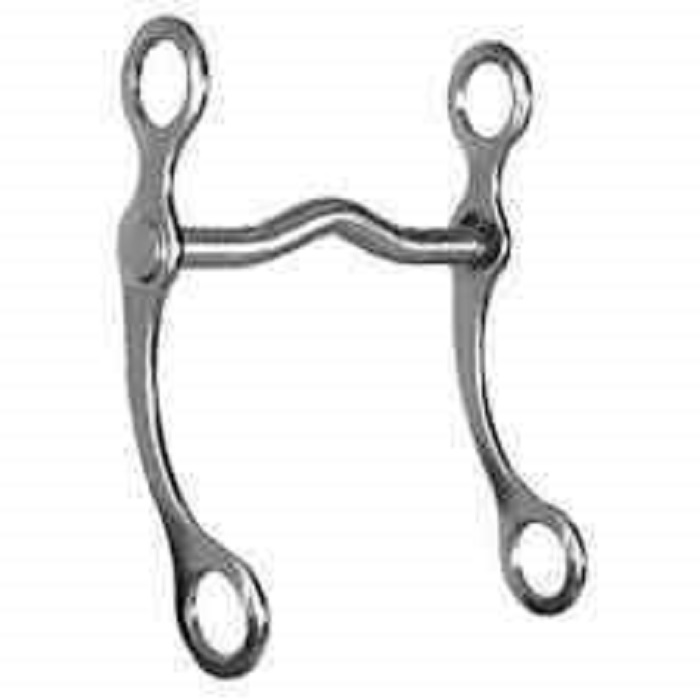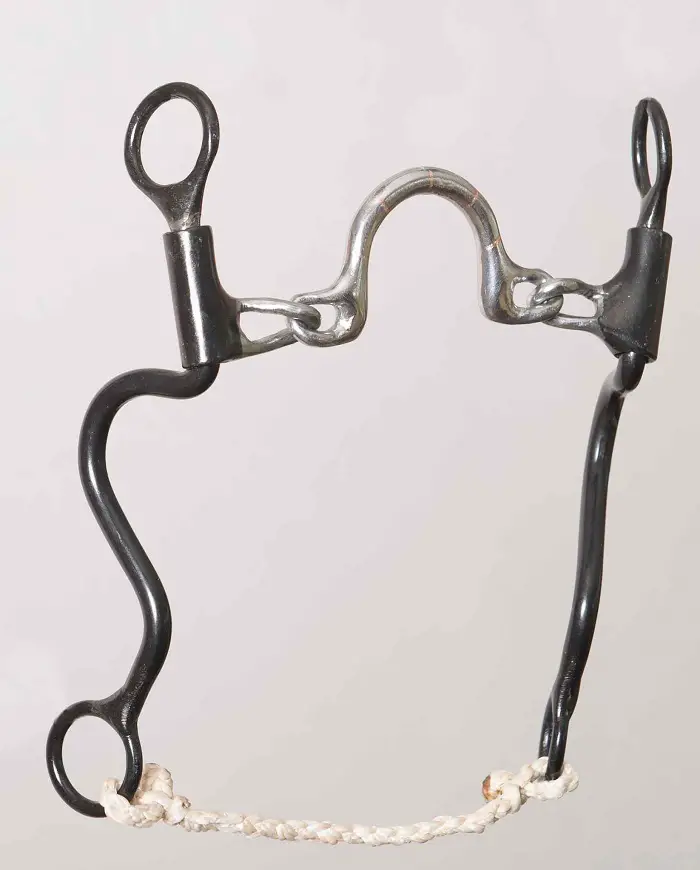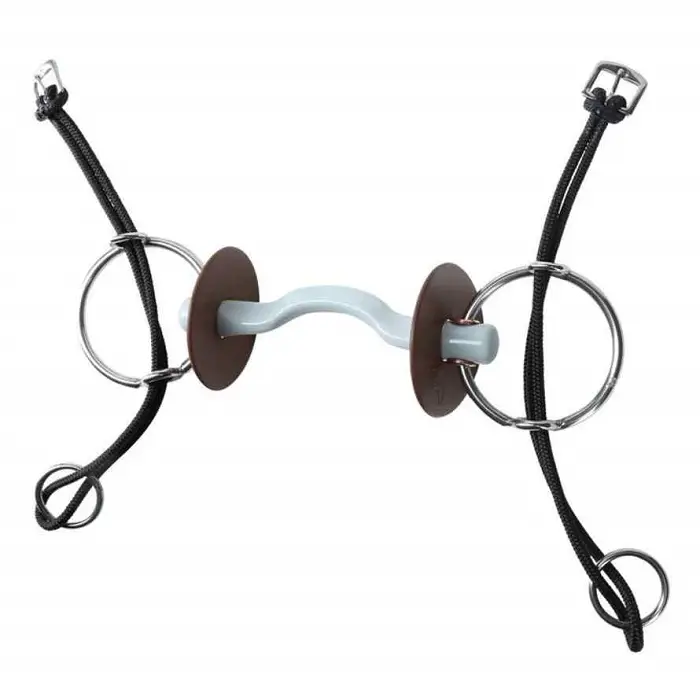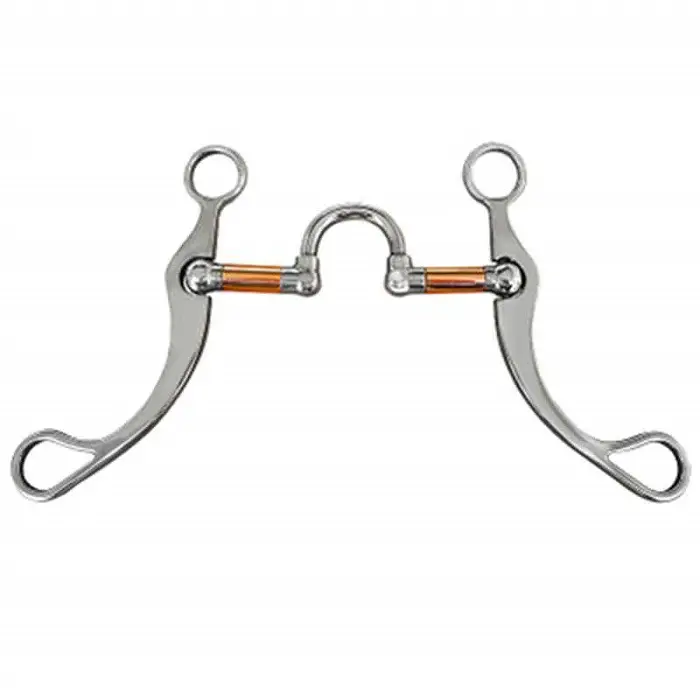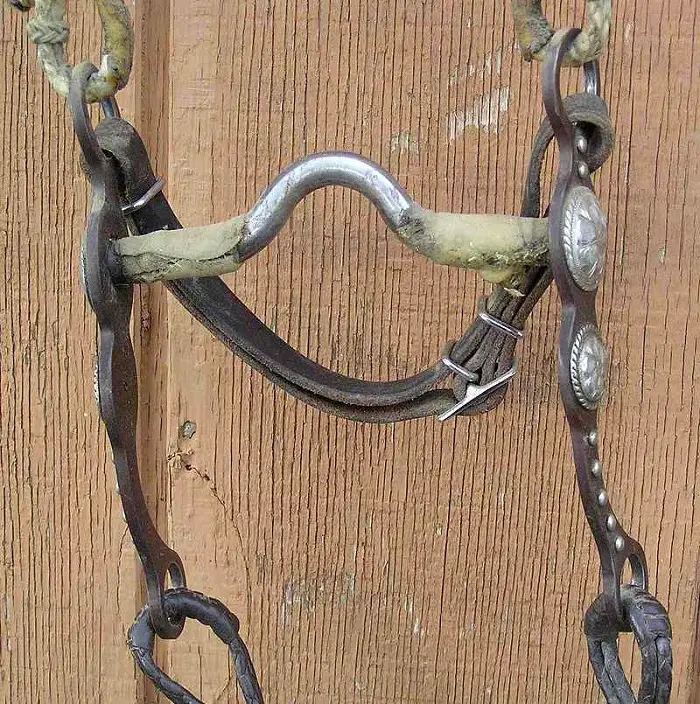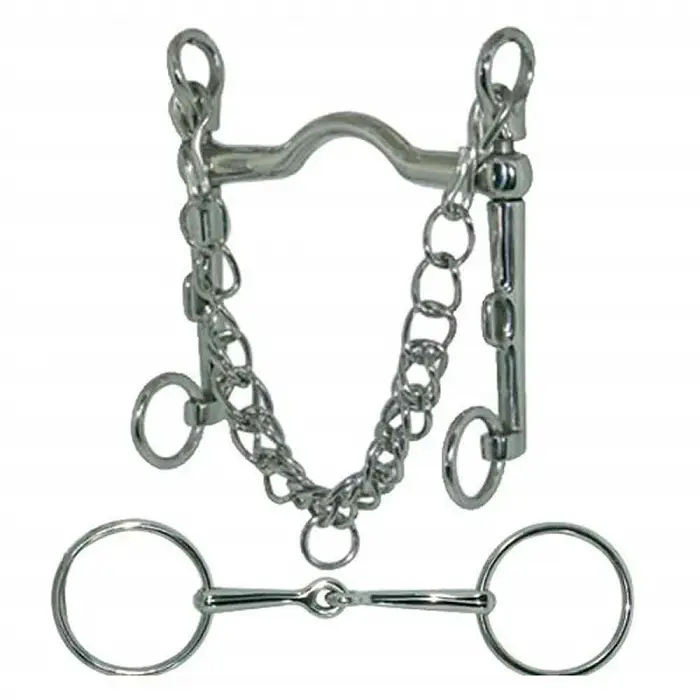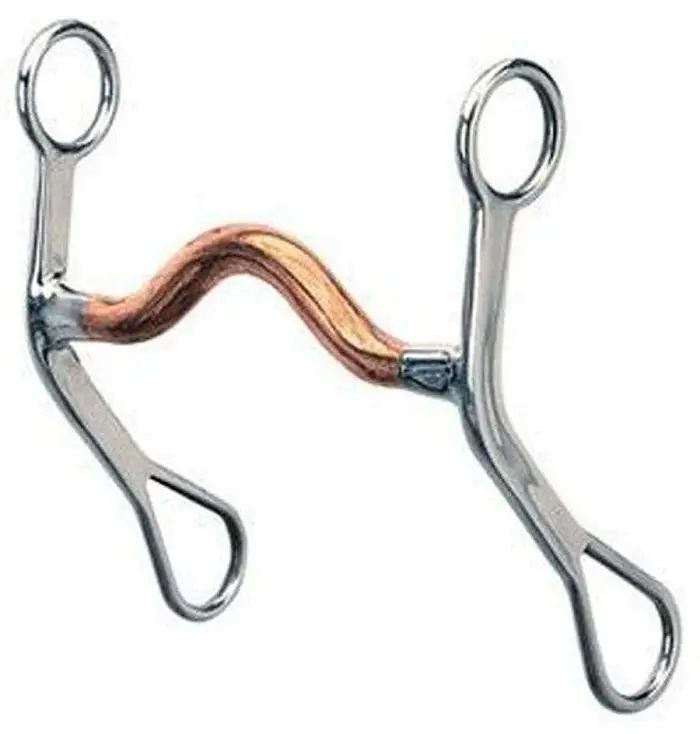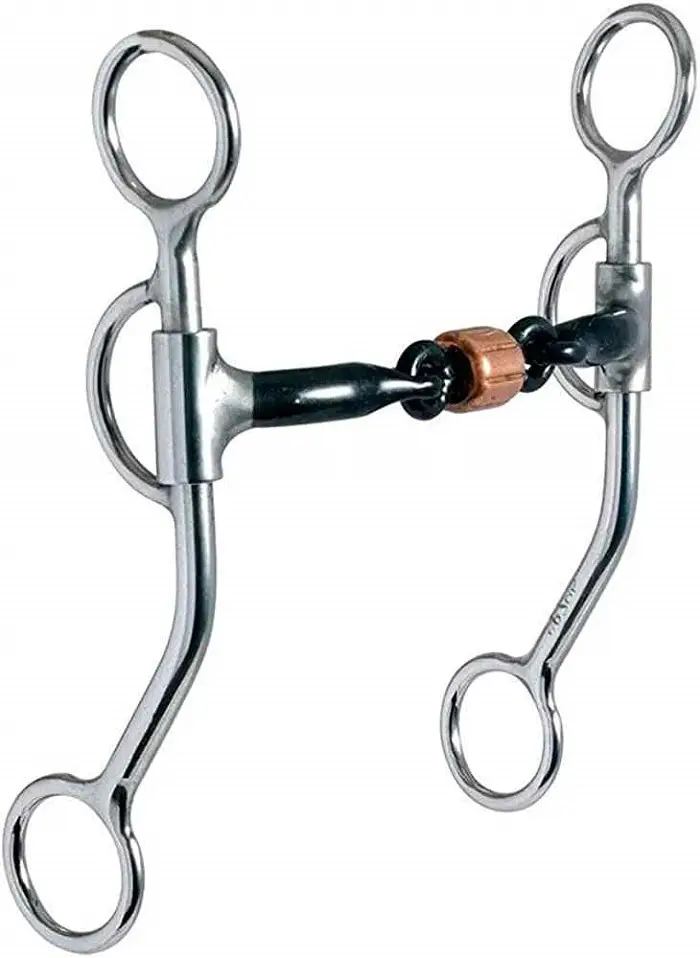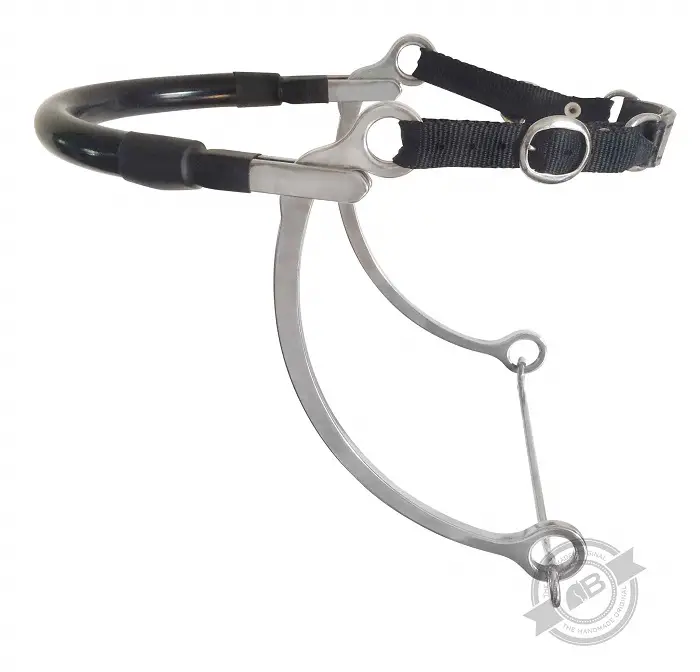Horse bits are an essential horse tack required for control and smooth riding. Horse mouth has toothless areas in the upper and lower chicks where the bits rest on the chicks and gums. When there is no pressure on the reins, the bits do not create pressure on the gums, and the horse is entirely comfortable. The rider applies pressure on the reins to control the horse; the bits give pressure on the tongue, gum, and associated structure. There are more than 50 types of horse bits in the world.
When you talk about types of horse bits, there are many options. There are mainly two types of bits; snaffle bits, curb bits, and a combination. The snaffle bit connects the reins of the mouthpiece through a ring attached to each side of the ring. On the other hand, the curb bit has a shank that connects to the long or short cheekpiece with the reins.
Most Common Types of Horse Bits
The most common and essential horse bits are discussed in the following paragraph:
1. D-Ring Snaffle
A D-ring snaffle is a type of bit used in horse riding. It consists of a mouthpiece, usually made of metal, and two rings on either side of the mouthpiece in the shape of a “D.” The reins are attached to the rings, and when the rider pulls on the reins, pressure is applied to the horse’s mouth through the mouthpiece.
The D-ring design helps prevent the bit from sliding too far through the horse’s mouth, which can be uncomfortable and give the rider less control. The shape of the D-ring also helps to guide the horse’s head and prevent the bit from pulling through the mouth.
D-ring snaffles are typically considered mild bits, making them a good choice for young or sensitive horses or riders who prefer a gentler approach. However, it’s important to remember that any bit can be harsh in the wrong hands, so it’s always best to use the mildest possible that allows the rider to communicate effectively with the horse.
2. Types of Horse Bits: Eggbutt French Link Snaffle
An eggbutt French link snaffle is a bit used in horse riding. It consists of a mouthpiece with two joints in the center, known as a French link, and two rings on either side of the mouthpiece, which are flat and oval-shaped, like an egg. The reins are attached to the rings.
The French link in the mouthpiece of the eggbutt snaffle helps to reduce the pressure on the horse’s tongue, as it allows for greater flexibility and movement of the bit. This can make it a good choice for horses with sensitive mouths or easily irritated by bits that put too much pressure on their tongue.
The eggbutt design of the snaffle helps prevent the bit from sliding too far through the horse’s mouth, which can be uncomfortable and give the rider less control. The eggbutt rings’ shape also helps guide the horse’s head and prevent the bit from pulling through the mouth.
Eggbutt French link snaffles are generally considered mild, making them a good choice for young or sensitive horses or riders who prefer a gentler approach. However, as with any bit, using it correctly and with proper training and handling techniques is essential to ensure the horse’s comfort and safety.
3. Loose Ring Polymer-Covered Mullen Snuffle
A loose ring polymer-covered mullen snaffle is a bit used in horse riding. It consists of a mouthpiece made of a hard rubber or plastic material covered in a polymer coating to provide a softer feel for the horse’s mouth. The mouthpiece is straight and has no joints, which makes it a “mullen” bit.
The loose ring design of the snaffle allows for more movement of the bit in the horse’s mouth, which can encourage the horse to chew and salivate, helping to promote relaxation and acceptance of the bit. The rings can also move freely, which can help reduce the amount of pressure on the horse’s mouth and give the rider more precise control.
The polymer covering on the mouthpiece helps make the horse more comfortable, providing a softer, more flexible surface for the horse’s mouth. This can make it a good choice for horses with sensitive mouths or for riders who prefer a gentler approach.
Loose ring polymer-covered mullen snaffles are generally considered mild bits, making them a good choice for young or sensitive horses or riders who prefer a gentler approach. However, as with any bit, using it correctly and with proper training and handling techniques is essential to ensure the horse’s comfort and safety.
4. Full Check Double Twisted Wire Snuffle
A full cheek double twisted wire snaffle is used in horse riding. It consists of a mouthpiece with two twisted wires in the center, which can create more severe and direct pressure on the horse’s mouth. The mouthpiece is attached to two long arms, which end in a vertical bar with a ring at the top and bottom. The top ring is used to attach the cheekpieces of the harness, while the bottom ring is used to attach the reins.
The snaffle’s complete cheek design helps guide the horse’s head and prevent the bit from pulling through the mouth. The vertical arms also help stabilize the bit in the horse’s mouth, which can be helpful for horses inclined to open their mouths or tend to pull against the bit.
The double twisted wire mouthpiece of the snaffle is more severe than many other types of bits and can create more direct and uncomfortable pressure on the horse’s mouth. This makes it a more advanced bit that should only be used by experienced riders who understand how to use it correctly.
Full cheek double twisted wire snaffles are generally not recommended for young or sensitive horses, as they can be too harsh and cause discomfort or pain. It’s essential to use this type of bit cautiously and to ensure the horse is properly trained and conditioned to accept and respond to it. Proper fitting, use, and care of the bit are also essential to ensure the horse’s comfort and safety.
5. Types of Horse Bits: Pelham Bit With Copper Link
A Pelham bit with a copper link is used in horse riding, combining elements of a snaffle and curb bit. It consists of a mouthpiece with a jointed or solid center and shanks that attach to the bit rings on either side of the mouthpiece. The shanks can be either short or long and have various shapes and designs.
The copper link in the Pelham bit’s mouthpiece helps promote salivation in the horse’s mouth, making the bit more comfortable and accessible for the horse to accept. The jointed center of the mouthpiece also allows for greater flexibility and movement, which can reduce pressure on the horse’s tongue.
The Pelham bit with a copper link is designed to be used with two sets of reins. The lower set of reins attaches to the bit rings, which allows the bit to function as a snaffle and apply direct pressure to the horse’s mouth. The upper set of reins attaches to the shanks, which allows the rider to apply additional leverage and pressure to the horse’s poll and chin. The combination of direct pressure and leverage can make the Pelham bit a powerful tool for an experienced rider.
Pelham bits with copper links are generally considered a more advanced type of bit and are best used by experienced riders who understand how to use them correctly. It’s vital to ensure that the bit is properly fitted and adjusted to the horse’s mouth and to use it with proper training and handling techniques to ensure the horse’s comfort and safety.
6. Kimberwick Bit With Medium Port and Roller
A Kimberwick bit with a medium port and roller is a type of bit used in horse riding. It is a hybrid between a snaffle and a curb bit, with a straight or slightly curved mouthpiece and fixed shanks that attach to the bit rings on either side of the mouthpiece.
The medium port in the mouthpiece of the Kimberwick bit creates space for the horse’s tongue, providing a more comfortable fit for horses with giant tongues or soft palates. The roller in the center of the port can also promote salivation and encourage the horse to relax and accept the bit.
The fixed shanks of the Kimberwick bit provide leverage and can amplify the rider’s rein aids, making it a more substantial bit than a snaffle but milder than a curb. The position of the rein attachment on the shanks determines the degree of leverage applied, with a higher attachment providing more leverage and a lower attachment providing less.
The Kimberwick bit is designed with one set of reins attached to the bit rings at the bottom of the shanks. The rider can apply direct pressure to the horse’s mouth using the reins like a snaffle or apply additional leverage using the reins like a curb.
Kimberwick bits with a medium port and roller are generally considered moderate, suitable for intermediate or experienced riders with horses accustomed to a more substantial bit. However, it’s essential to ensure that the bit is fitted correctly and adjusted to the horse’s mouth and to use it with proper training and handling techniques to ensure the horse’s comfort and safety.
7. Types of Horse Bits: Double Briddle
A double bridle, also known as a full bridle, is a type of harness used in horse riding that includes two bits and two sets of reins. The double bridle is typically used in dressage, allowing for precise communication between the rider and the horse.
The double harness consists of a snaffle bit and a curb bit. The snaffle bit is typically a simple jointed or unjointed bit, while the curb bit has a port or a solid mouthpiece and shanks that provide leverage.
The snaffle bit is positioned in the horse’s mouth like a standard snaffle bit, with the reins attached to the bit rings. The curb bit is positioned below the snaffle bit, with the reins attached to the lower set of rings on the shanks.
The rider uses the reins on the snaffle bit to communicate direct pressure to the horse’s mouth, while the reins on the curb bit provide leverage and allow the rider to communicate more subtle commands to the horse.
The double harness requires much skill and experience to use correctly. It is generally recommended only for experienced riders who thoroughly understand how to use the bit and the reins to communicate effectively with the horse. It’s also essential to ensure that the double harness is fitted correctly and adjusted to the horse’s mouth and that the horse is trained and conditioned to accept and respond to the bit.
8. Types of Horse Bits: Hanging Cheek Snuffle
The Hanging Cheek Snaffle is a type of bit that is commonly used in horse riding. It consists of a straight mouthpiece and a cheekpiece hanging from the bit. The hanging cheekpiece creates a slight leverage effect, which applies a little bit of pressure to the horse’s poll (the top of its head) and helps to encourage the horse to lower its head and soften its jaw.
The Snaffle part of the bit means it has a simple mouthpiece, and there is no leverage effect like a Pelham or a Weymouth.
The Snaffle bit is often used for young horses or horses just starting to learn to carry a bit and respond to the rider’s aids. The Hanging Cheek Snaffle can be helpful in horses that raise their heads too high or have difficulty relaxing their jaw and neck.
It’s important to note that the effectiveness and suitability of a bit depend on several factors, including the horse’s temperament, mouth shape, and level of training. A qualified equestrian professional should be consulted to determine the best bit for each horse and rider combination.
9. Types of Horse Bits: Tom Thumb Bits
The Tom Thumb bit is a type of bit commonly used in horse riding. It is a type of bit with a jointed mouthpiece, shanks, and a curb chain. The shanks on a Tom Thumb bit are relatively short, making it mild.
However, it is essential to note that the Tom Thumb bit can be severe in the wrong hands. It puts pressure on the horse’s poll and chin groove and can cause the horse to brace against the bit. Therefore, it should only be used by experienced riders with a light hand who can adequately use the bit to communicate with the horse.
It is also essential to ensure that the bit fits appropriately in the horse’s mouth and that the rider uses appropriate rein aids to avoid causing unnecessary discomfort or pain to the horse. If you are still determining whether the Tom Thumb bit is appropriate for your horse or riding style, it is always best to consult a knowledgeable trainer or equine professional.
10. Types of Horse Bits: Ported Curb Bit
A ported curb bit is commonly used in horse riding with a high, arched port in the center of the mouthpiece. The port allows more room for the horse’s tongue, which can be more comfortable for some horses than bits with a straight mouthpiece. The ported curb bit also has shanks and a curb chain, which create pressure on the horse’s poll and chin groove.
The severity of the ported curb bit depends on the port height and the shanks’ length. A higher port and longer shanks will create more pressure on the horse’s mouth and chin and can be pretty severe in the hands of an inexperienced or heavy-handed rider.
Ported curb bits are often used in Western riding, particularly in disciplines such as reining and cutting. However, it is essential to note that, like any bit, it should be used with care and consideration for the horse’s comfort and well-being. A properly fitting bit, adjusted correctly in the horse’s mouth, should be comfortable for the horse and allow the rider to communicate effectively without causing unnecessary pain or discomfort. It is always best to consult a knowledgeable trainer or equine professional if you have questions about whether a ported curb bit is appropriate for your horse and riding style.
11. Chain Bit with Port and Cavalry Shank
A chain bit with port and cavalry shank is commonly used in horse riding, particularly in Western disciplines such as cutting and reining. The bit features a chain mouthpiece with a port, allowing more room for the horse’s tongue, and cavalry shanks, typically longer than the shanks on a standard curb bit.
The chain mouthpiece on this bit creates a harsher effect than a solid mouthpiece, as it has more pressure points and can be more severe in the hands of an inexperienced or heavy-handed rider. The ported mouthpiece relieves the horse’s tongue and can be more comfortable for some horses.
The cavalry shanks on this bit increase the leverage action of the bit, which can amplify the pressure on the horse’s mouth and chin. As with any bit, it is crucial to ensure that it is properly adjusted and fitted to the horse’s mouth and that the rider uses appropriate rein aids to avoid causing unnecessary discomfort or pain.
It is worth noting that experienced riders should only use the chain bit with port and cavalry shank with a light hand who can properly use it to communicate with the horse. If you are still determining whether this type of bit is appropriate for your horse or riding style, it is always best to consult a knowledgeable trainer or equine professional.
12. Types of Horse Bits: Gag Bit
A gag bit is commonly used in horse riding, particularly in sports like show jumping and eventing. The bit features a mouthpiece with two rings on either side and two sets of reins. The reins that attach to the bit rings apply pressure to the horse’s poll, while those that attach to the lower rings apply pressure to the horse’s mouth. When the rider pulls on the lower reins, the bit rotates in the horse’s mouth and applies pressure to the poll.
The gag bit gives the rider more control over the horse, particularly when approaching jumps or other obstacles. However, correctly using the gag bit is essential, as it can be severe in the wrong hands. Experienced riders should only use it with a light hand and can adequately use the bit to communicate with the horse.
It is also essential to ensure that the gag bit is appropriately adjusted and fitted to the horse’s mouth and that the rider uses appropriate rein aids to avoid causing unnecessary discomfort or pain. If you are still determining whether a gag bit is appropriate for your horse or riding style, it is always best to consult a knowledgeable trainer or equine professional.
13. Types of Horse Bits: Correction Bit for Horses
A correction bit is a type of bit commonly used in horse riding to more control over the horse’s movements. The ported mouthpiece provides more room for the horse’s tongue, and the longer shanks create more leverage, amplifying the pressure on the horse’s mouth and chin.
However, it is essential to note that the correct bit can be severe in the wrong hands. Experienced riders should only use it with a light hand and can adequately use the bit to communicate with the horse. It is also essential to ensure that the correction bit is appropriately adjusted and fitted to the horse’s mouth and that the rider uses appropriate rein aids to avoid causing unnecessary discomfort or pain.
Suppose you still determine whether a correction bit is appropriate for your horse or riding style. In that case, consulting with a knowledgeable trainer or equine professional is always best. It is also worth noting that many other types of bits are available. The best bit for your horse may vary depending on various factors, including your horse’s conformation, temperament, and training level.
14. Mullen Mouth Curb Bit with Grazing Shank
A mullen mouth curb bit with a grazing shank is commonly used in horse riding, particularly dressage and pleasure riding disciplines. The bit features a mouthpiece with a straight bar, known as a mullen mouth, which sits across the horse’s tongue and bars. The grazing shanks on this bit are typically longer than those on a standard curb bit, providing more leverage and amplifying the pressure on the horse’s mouth and chin.
The mullen mouth curb bit is designed to be relatively mild, as the straight bar distributes pressure evenly across the horse’s mouth. The grazing shanks, however, can make the bit quite severe in the hands of an inexperienced or heavy-handed rider.
It is essential to ensure that the mullen mouth curb bit with grazing shank is appropriately adjusted and fitted to the horse’s mouth and that the rider uses appropriate rein aids to avoid causing unnecessary discomfort or pain to the horse. If you are still determining whether this type of bit is appropriate for your horse or riding style, it is always best to consult a knowledgeable trainer or equine professional. They can help determine if this bit suits your horse’s needs and abilities.
15. Cathedral Bit/ Spoon Bit with Sweet Iron
A spoon bit with sweet iron is commonly used in horse riding, particularly in Western disciplines such as reining and cutting. The bit features a curved mouthpiece shaped like a spoon and made of sweet iron.
Sweet iron is a metal known for its taste and smell, which can help encourage the horse to salivate and accept the bit more readily. As the horse salivates, the bit becomes more comfortable in its mouth. However, it is worth noting that sweet iron bits can rust over time, so it is essential to clean and care for the bit correctly.
The spoon mouthpiece on this bit provides a relatively mild action as it distributes pressure evenly across the horse’s tongue and bars. This makes it a good choice for sensitive horses or with a low tolerance for more severe bits.
It is essential to ensure that the spoon bit with sweet iron is appropriately adjusted and fitted to the horse’s mouth and that the rider uses appropriate rein aids to avoid causing unnecessary discomfort or pain. If you are still determining whether this type of bit is appropriate for your horse or riding style, it is always best to consult a knowledgeable trainer or equine professional. They can help determine if this bit suits your horse’s needs and abilities.
16. Types of Horse Bits: Weymouth Curb and Bradoon
A Weymouth bit, a double bridle, is commonly used in horse riding, particularly in dressage and other formal riding disciplines. The Weymouth bit comprises two separate bits: a curb bit and a bradoon bit.
The curb bit is the lower of the two bits, similar to a standard curb bit. It features a curved mouthpiece and shanks that apply pressure to the horse’s chin and mouth. The bradoon bit is the upper bit, typically a thinner, more straightforward bit with a straight mouthpiece.
When used together, the Weymouth bit gives the rider more control over the horse’s movements and head carriage and more subtle communication with the horse. However, it is essential to note that the Weymouth bit is relatively severe and should only be used by experienced riders with a light hand who can adequately communicate with the horse.
It is also essential to ensure that the Weymouth bit is adjusted correctly and fitted to the horse’s mouth and that the rider uses appropriate rein aids to avoid causing unnecessary discomfort or pain. If you are still determining whether a Weymouth bit is appropriate for your horse or riding style, it is always best to consult a knowledgeable trainer or equine professional.
17. Types of Horse Bits: Western Grazing Bit
A Western grazing bit is commonly used in Western riding disciplines, such as trail or ranch work. The grazing bit is typically made of stainless steel and features a straight or slightly curved mouthpiece with a port in the center to provide more room for the horse’s tongue.
The Western grazing bit also features shanks typically longer than those on a standard snaffle bit, providing more leverage and amplifying the pressure on the horse’s mouth and chin. The longer shanks also typically feature a slight curve, which helps to keep the bit from sliding through the horse’s mouth.
The Western grazing bit is designed to be relatively mild, as the straight or slightly curved mouthpiece distributes pressure evenly across the horse’s mouth. However, the longer shanks can make the bit quite severe in the hands of an inexperienced or heavy-handed rider.
It is essential to ensure that the Western grazing bit is properly adjusted and fitted to the horse’s mouth and that the rider uses appropriate rein aids to avoid causing unnecessary discomfort or pain. If you are still determining whether this type of bit is appropriate for your horse or riding style, it is always best to consult a knowledgeable trainer or equine professional. They can help determine if this bit suits your horse’s needs and abilities.
18. Types of Horse Bits: S-Shank Snuffle
An S-Shank snaffle is commonly used in horse riding, particularly in Western disciplines. The bit features a straight or slightly curved mouthpiece with a joint in the center that allows the bit to bend in the horse’s mouth. The S-shaped shanks extending upward from the mouthpiece give the bit its name.
The S-Shank snaffle provides more leverage than a traditional snaffle bit, which can amplify the pressure on the horse’s mouth and poll. However, the S-Shank snaffle is typically milder than other curb bits with longer shanks, as the shorter shanks provide less leverage.
The S-Shank snaffle is commonly used in Western riding, particularly in barrel racing and rodeo events. The bit allows the rider to control the horse’s movements better, particularly when making tight turns or sudden stops.
It is essential to ensure that the S-Shank snaffle is appropriately adjusted and fitted to the horse’s mouth and that the rider uses appropriate rein aids to avoid causing unnecessary discomfort or pain. If you are still determining whether this type of bit is appropriate for your horse or riding style, it is always best to consult a knowledgeable trainer or equine professional. They can help determine if this bit suits your horse’s needs and abilities.
19. Hackamore Bit for Horses
A hackamore, also known as a bitless bridle, is a type of headgear used in horse riding that doesn’t have a traditional bit. Instead, the hackamore relies on the pressure applied to the horse’s nose and jaw to control the horse’s movements.
The hackamore consists of a noseband that encircles the horse’s nose and is attached to reins or other straps connecting to the rider’s hands. There are several hackamores, including the mechanical hackamore, the bosal hackamore, and the side-pull hackamore.
The mechanical hackamore uses leverage to apply pressure to the horse’s nose and jaw, similar to a curb bit. The bosal hackamore features a stiff noseband made of braided rawhide or other materials and is commonly used in Western riding disciplines. The side-pull hackamore is similar to a halt and relies on direct pressure applied to the horse’s nose and jaw.
Hackamores are often used on young horses or horses with sensitive mouths, as they don’t rely on a metal bit and can be more comfortable for the horse. However, it is essential to note that hackamores can still be severe if misused and cause discomfort or pain if excessive pressure is applied.
Suppose you are considering using a hackamore for your horse. In that case, working with a knowledgeable trainer or equine professional is vital to ensure that the hackamore is appropriately adjusted and fitted to your horse’s head and that you are using appropriate rein aids to avoid causing unnecessary discomfort or pain to the horse.
Concluding Remarks on Types of Bits
In conclusion, many different types of bits are available for horses, each with advantages and disadvantages. It’s essential to choose the right bit for your horse’s needs and abilities, as well as your riding style and experience level.
When selecting a bit, consider factors such as the horse’s mouth shape and sensitivity and the riding you will be doing. Always ensure that the bit is fitted correctly and adjusted, and use appropriate rein aids to avoid causing discomfort or pain to the horse.
Additionally, it’s important to remember that the bit is just one aspect of effective communication between horse and rider. Other factors, such as proper training, conditioning, and overall horse care, are crucial in achieving a safe and successful riding experience.
